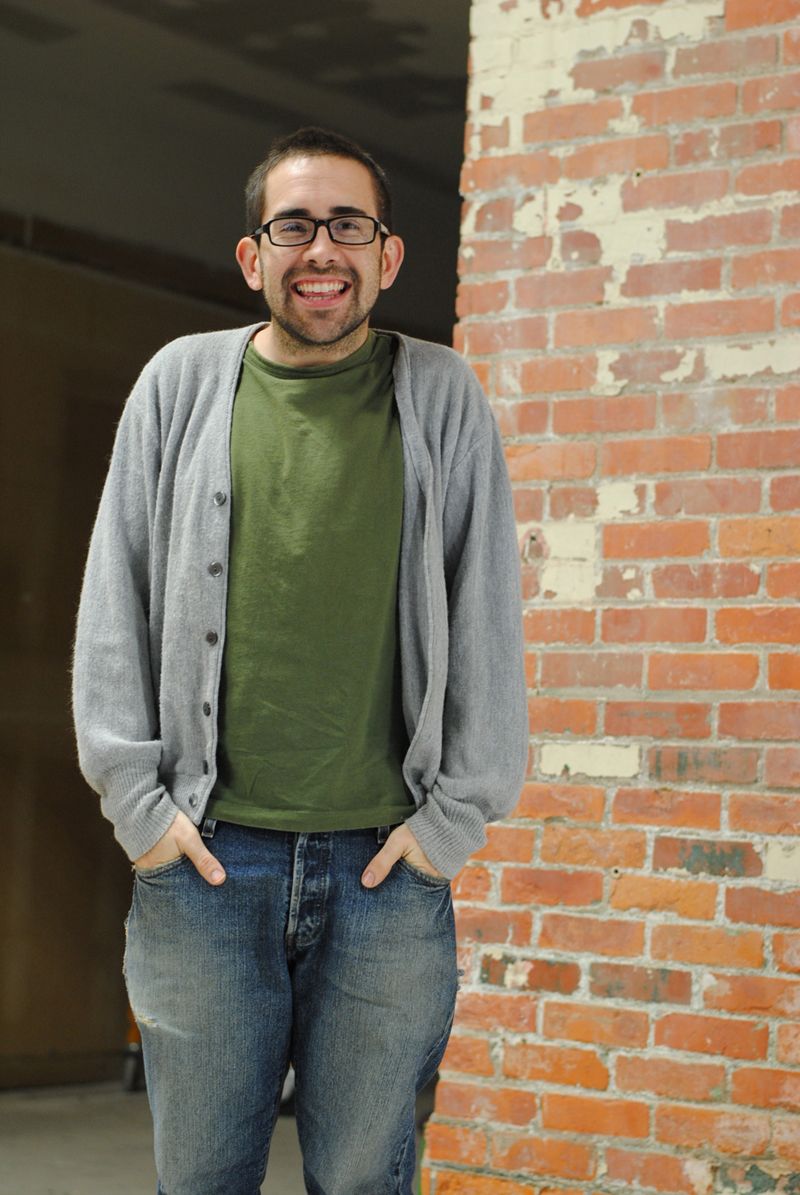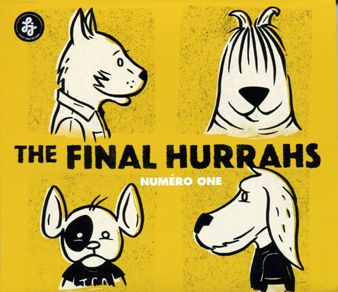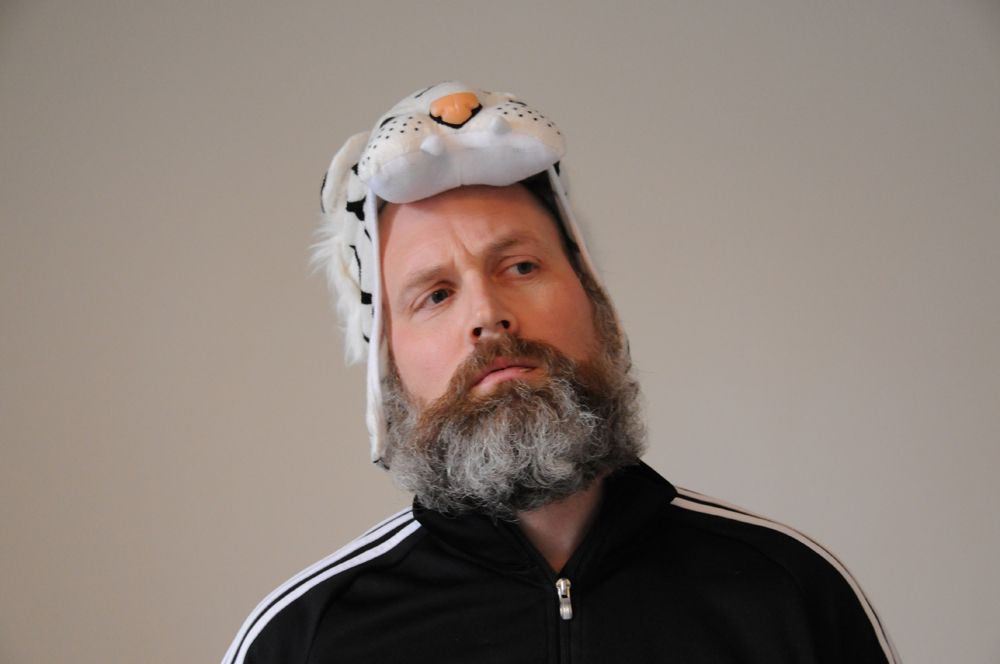Tucked up in a $3 padded chair scavenged from a recent GE auction, I leaned close to a tiny space heater, hoping that my chilled red nose would go unnoticed as I listened to local artist and curator, Dan Swartz, divulge his master plan to introduce Fort Wayne to the edgy side of contemporary art. By the end of that day, electricians were expected to flip the switch, sending juice through a web of brand new wiring and heat blasting out of shiny air ducts. Swartz, with the disproportionate strength of an ant, has worked the past several months filling eight dumpsters with crushed drywall, crusty carpet and other remnants of the old Casa D’Angelo’s restaurant. The building at 3402 Fairfield Avenue has been transformed into the home of Swartz’s nonprofit brainchild, Wunderkammer Company.
Swartz’s mission is to “revitalize communities through contemporary art.” At first the tag line may pass through one ear and out the other, with a quick mumbling in between of “whatever, art guy. Good luck saving the world.” After a few minutes of listening to Swartz enthusiastically explain his plans for Wunderkammer, I couldn’t help being sucked in and soon found myself fist-pumping and chanting “art power.” Okay, so there was no fist-pumping, but there was discussion – lots of discussion. Swartz’s head spews ideas faster than my pencil could collect.
Unlike many 20-somethings, Swartz has a clear vision and a mission. He has a strong passion for community development and intends to use the nonprofit as a vehicle to push his ideas forward.
“We want to reclaim Fort Wayne, look at the neglected and forgotten resources and make those places cool again,” Swartz explained. “We have lost our identity, whatever that may be, and we need to reconnect with that.”
Bringing a new identity to an old building, Wunderkammer plans to open its doors on December 15, with a four-exhibit gallery show. The first exhibit, a project called 1×1, is a photo essay representing the full city limits of Fort Wayne. The project stems from Swartz’s contemplations of Fort Wayne’s identity and a deep love for the city’s history.
“It’s a 16-month project showing 16 segments of Fort Wayne,” said Swartz. “The project shows one chunk of Fort Wayne, one month at a time. We want to showcase the visual identity of our city.” Photographers were asked to capture the essence of each slice of the community. Swartz hopes that the project will put a spotlight on some of the forgotten spaces and allow photographers to jump into the city planning conversation.
“Photographers aren’t involved in city planning, even though they are actually walking through the city and taking intimate shots of areas that have been forgotten by the general population,” he said.
Swartz hopes that the exhibit will provide an honest representation of our city and uncover some of the cool things that exist in unexpected places. As with all his projects, Swartz hopes to spark a fire in the hearts of others who wish to brighten our community. Wunderkammer will show one chunk of 1×1 which will include about 56 photos. The show, juried by Karen Thompson, former professor of photography at Saint Francis, was funded by a grant from Arts United.
Investigating the identity of our city will lay the foundation for similar projects to follow. Swartz hopes to host exhibits that are produced by members of the community. The Saint Francis University photo club will produce his first group show.
“Group shows offer viewers many perspectives and takes on different subjects,” Swartz explains. “Unique interpretations will help the community become familiar with contemporary culture.” Saint Francis students prepare to offer their tongue-in-cheek responses to what some believe to be the day the world will end. The project is open to interpretation and promises to be quirky, unusual and perhaps shocking. A well-prepared patron will come equipped with a roll of duct tape and a few bottles of water, just in case. The opening is scheduled for December 15, just before the end of times.
The End of Times show will run parallel with a perfectly placed exhibit titled EX, meaning exquisite corpse. The show questions the idea of control, as the usual relationship between artist and curator is turned inside out. The concept removes the curator’s usual function, which is to choose the work to be included in a show and narrate the display with his or her own vocabulary. In the case of EX, curators were given a collection of finished works and asked to bring meaning to the pieces by strategic placement. On the opposing end, artists were directed to create work of a certain subject, in this case a human body. The artists were also stripped of their voice to direct how the work should be displayed. The role reversal presents an entirely new set of problems for the creative team while at the same time opening a wide range of new conversations. The show first opened in March 2012 in New York City, then traveled to Chicago in May.
“With each show being curated by a different person, it changes completely in each city,” says Swartz, who will curate the Fort Wayne show that will include 27 images. EX opens on December 15.
Wunderkammer’s opening will be topped off with the remnants of a show that occurred in 2010-11. Not Tony Smith, is a project that involved the placement of moveable sculptures in a variety of public spaces. The project was a covert effort to engage an atypical audience in the creation of art. In simple terms, people were tempted to move chunks of sculpture to make new sculptures, the same way a kid knocks over another kids block tower, then makes a new block tower that stands until a third kid comes along, and so on.
The social experiment produced interesting results. Collaboration occurred between the homeless and the random. Curious creative types stacked pieces while occupy campers tore them down. The pieces endured weather and a few beatings, but the damage was justified. Just as a favorite toy may lose an arm or an eyeball, Not Tony Smith earned its scrapes and scars with purpose and flaunts them with pride.
The installation will be reconstructed in time for Wunderkammer’s opening and dismantled and retired on January 31 as the gallery clears its floors and walls in preparation for Fort Wayne’s first official Fringe Fest.
What’s a Fringe Fest? In Swartz’s words, a Fringe Fest is a “glorification and expression of performance art of any kind.” Typically large, elaborate events, Fort Wayne’s first attempt will be small, using two spaces within the Wunderkammer building. Swartz expects 10 artists and 20 performances to occur over a four-day span. Wunderkammer has received applications from artists from Chicago, Ann Arbor, Columbus and Atlanta.
Before the doors have even opened, Wunderkammer is getting attention from artists in cities across the region. During the past six months, Wunderkammer construction has raised the curiosity of surrounding neighbors. Swartz states that he has had a “flow of random people, curious about what’s going on inside stop by,” so many visitors that he habitually locks the door behind him so he can work without interruption.
Working to gut and revitalize a building while planning and setting four exhibits has left Swartz feeling, “emotionally and physically void … leaving me unable to be creative.” I have to disagree. This guy’s brain is a bubbling pot of magma, waiting to blow. His conversations are speckled with lessons in art history, politics, societal reform and passion for making the world a better place. He wants people to realize that contemporary art is made for and by people that could easily, and likely do, live in the house next door.
“Most of us are just normal people who care about expressing ourselves and sharing new ideas,” says Swartz. “I just want the community to open up to contemporary art a little bit.”
There are people out here, Mr. Swartz, who are drooling over your menu of contemporary culture. We are waiting for a taste of an art scene typically reserved for big cities. Ding-dong. Unlock the door. The restaurant may be closed, but Wunderkammer is open for business.



